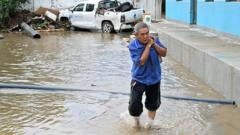A nursing home in Beijing's Miyun District succumbed to devastating floods this week, resulting in the tragic deaths of 31 elderly residents. Officials admit to flawed emergency planning as extreme weather events escalate across China.
Tragedy Strikes Nursing Home as Beijing Floods Claim 31 Lives

Tragedy Strikes Nursing Home as Beijing Floods Claim 31 Lives
Severe flooding in Beijing leads to the loss of life at a nursing home, raising concerns about emergency preparedness and extreme weather management.
Flooding in Beijing has resulted in a devastating toll, with 31 residents of a nursing home losing their lives. Local authorities reported that the care home, located in the Miyun District, was overtaken by floodwaters, leading to frantic rescue attempts by emergency teams who waded through water reaching chest height. Many of the deceased were reportedly immobile and unable to escape the rising waters.
In total, the floods have claimed 44 lives in the Beijing region, occurring amid a summer marked by severe weather across China. Earlier this month, record heatwaves impacted eastern areas, while separate flooding events significantly affected the south-west. Official reports indicated that around 77 elderly individuals were present in the home when the floods occurred, leaving approximately 40 residents trapped as water levels surged to nearly 2 meters (6 feet).
This facility, situated in Taishitun Town, is primarily designed to care for those who are severely disabled, financially challenged, or receiving limited living allowances. During a press conference, a government representative stated, "The area where the nursing home is located had long been considered secure, and as a result, it was not included in the evacuation plan's scope." The official acknowledged the need to reassess emergency preparedness, noting that this incident served as a "painful lesson" and a "wake-up call" regarding their understanding of extreme weather.
In nearby Hebei province, the toll from extreme rainfall recorded 16 deaths, with Chengde city alone facing eight fatalities and 18 residents still unaccounted for. Historically, Beijing has faced flooding challenges, particularly in the summer months. One of the most catastrophic flooding incidents occurred in July 2012, when a single day saw 190mm of rain fall, resulting in 79 deaths.
This summer's floods have wreaked widespread destruction throughout various regions of China. Earlier this month, Typhoon Wipha brought tragedy to Shandong province, resulting in two deaths and 10 individuals reported missing. Furthermore, a landslide in Ya'an city claimed three lives two weeks ago. Climate change experts link the increasing frequency and intensity of such natural disasters to the growing threat to China’s citizens and economy, particularly endangering its multi-trillion dollar agricultural sector.
In the first half of 2023 alone, natural disasters inflicted a staggering cost of 54.11 billion yuan ($7.5 billion; £5.7 billion) on China, according to the emergency management ministry. Notably, flooding accounted for more than 90% of this financial loss. As officials continue to confront the aftermath of these floods, significant concerns about emergency preparedness and the potential impact of climate change on future weather events remain at the forefront of discussions.





















